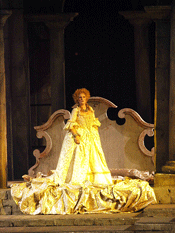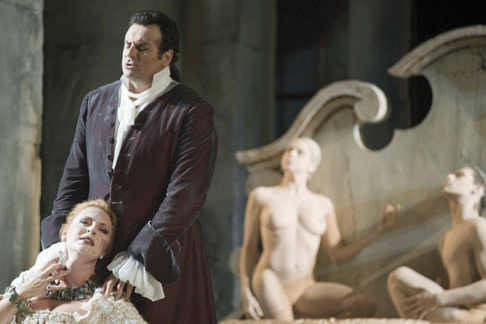What set this production apart was the inclusion of a prelude to Act II that had been part of an earlier draft of the work, along with a scene of the two lovers living happily in Paris. Aside from being too similar to Massenet’s Manon (‘adieu à la petite table’), Puccini cut the scene to move directly from the lovers’ flight from Amiens to Geronte’s mansion where Manon, having abandoned the penniless des Grieux, luxuriated as Geronte’s mistress. The fully orchestrated prelude had gone unperformed until Chailly’s 1984 recording of rarely performed works (a recording that is currently difficult to find). With this production, Maestro Veronesi performed the prelude as an integral part of the entire work.
 Martina Serafin as Manon
Martina Serafin as Manon
A minuet in form, the prelude, rife with melancholy, evoked the flame of the lovers’ intense, but short-lived affair. More importantly, the prelude evidenced Puccini’s mastering of 20th century musical theater that incorporated Wagner’s rich symphonic approach and anticipated Janáček’s use of repetitive fragments (“interruption motifs”) and of his orchestration, often with programmatic origins, “capable of great sweetness [yet with] a roughness caused by the unblended layers of orchestra and by the seemingly unidiomatic writing in individual parts.” [John Tyrrell, “Janáček, Leoš [Leo Eugen],” Grove Music Online]
Guided by Maestro Veronesi, the Puccini Festival Orchestra has matured significantly over the past five years. In this production of Manon Lescaut, the orchestra traversed the difficult score masterfully, both in supporting the singers (à la Verdi) and in performing program music (such as the intermezzo between Act II and Act III) with aplomb. It was difficult, however, to appreciate all of the orchestra’s subtleties in the upper rows of the 3,500-seat open air auditorium.
Passion, even carnal passion, paradoxically devoid of erotic love and desire, inspired Verdian melodrama. Manon Lescaut, on the other hand, returned erotic expression as a central element of Italian opera. The erotic aspects of Manon Lescaut are expressed with increasing intensity by the two principals, Manon and des Grieux, from the youthful aria “Donna non vidi mai” (Act I), to the duet “Tu, tu amore tu” (Act II), to the aria “No! no!, pazzo son” (Act III), to the desperate “Sola, perduta, abbandonata” (Act IV). Marcello Giordani and Martina Serafin executed these roles with perfection. Giordani’s wide register and power filled the auditorium, recalling the finest of performances by Domingo in the mid-1980s. Serafin, mostly noted for her performances of Wagner and Strauss, added a Wagnerian touch to “Sola, perduta, abbandonata” that aligned well with Veronesi’s conducting, her performance of the role being closer to that of Renata Scotto rather than that of the more lyrical Mirella Freni. Comprimario roles — Lescaut (Giovanni Guagliardo), Edmondo (Cristian Olivieri), Geronte (Alessandro Guerzoni) — were adequate, yet overwhelmed by Giordani and Serafin.
 Martina Serafin as Manon and Marcello Giordani as des Grieux
Martina Serafin as Manon and Marcello Giordani as des Grieux
Significant weaknesses of this production arose from the contributions of Paul-Emile Fourny (director) and Poppi Ranchetti (sets). Little attention was paid to the singers’ acting . And the staging included a crowd of mimes (ostensibly naked) and dancers, the relevance of which remained unclear. The set transformed from a Renaissance ninfeo by Bramante (a 15th century architect) to a villa near Rome that deteriorated in appearance from one act to another (seemingly intended to mirror the degradation of Manon and des Grieux), all having a bewildering effect.
Giuseppe Pennisi


